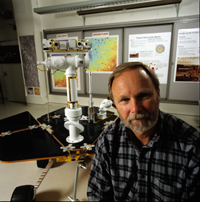The Earth and Planetary Remote Sensing Laboratory has received a grant of $1.8 million per year for the next five years to extend and improve the Geosciences Node of the Planetary Data System (PDS), a distributed data system that archives and distributes planetary data from space missions.
The Geosciences Node of the PDS, housed in the Department of Earth and Planetary Sciences in Arts & Sciences at Washington University in St. Louis, holds data about the surfaces and interiors of the terrestrial planets Mercury, Venus and Mars and Earth’s Moon.
The laboratory, directed by Raymond E. Arvidson, Ph.D., the James S. McDonnell Distinguished University Professor, is involved in many aspects of NASA’s planetary exploration program in addition to data archiving, including developing mission plans and participating in mission operations. Most recently, the lab has been helping to run the Spirit and Opportunity rovers that are exploring the surface of Mars.

The PDS was conceived by Arvidson and Ralph Bernstein of International Business Machines in the late 1980s when they were serving on a National Research Council committee that had been tasked with the problem of how to preserve the ever-increasing volume of digital science data collected by planetary missions.
Before the PDS, nobody paid much attention to what happened to the data after a mission, says Arvidson, who directs the Geosciences Node. “You flew the instrument, got the data, published the results and at the last minute dumped the archives into some federal facility.” The data wasn’t always complete or in usable form.
One of the innovations the PDS introduced was peer review. Before they are archived at the PDS, data sets are reviewed by a panel of scientists in a way similar to the review of a paper for a scientific journal. Data sets must meet standards for science quality and completeness before PDS releases them to the public.
The PDS’ goal is to ensure data are useable for at least 50 years after they are acquired, no small undertaking considering how quickly even the storage media have been changing.
The laboratory recently began a long-term effort to recover data from the early lunar missions, including the Apollo Program.
Another innovation of the PDS was to give custody of the data to the scientists who would be working with it. The Geosciences Node is located in St. Louis because of the research interests of the scientists there. The University of Maryland stores the data on small bodies such as asteroids, New Mexico State University archives data on atmospheres, and so on.
The Geosciences Node holds about 50 terabytes of data in 10 million files, and the archive is expected to swell to 230 terabytes in the next five years as data streams in from active missions. Most of what is known or could be known about the terrestrial planets, in other words, is sitting on servers on the WUSTL campus.
While the PDS primarily serves the planetary science community, the data are available for free to anyone with a Web connection. The laboratory has developed two interactive Web-based interfaces: Analyst’s Notebooks for lander and rover mission data and Orbital Data Explorers for orbiter-derived data.
The Analyst’s Notebooks, for example, allow a user to play back key aspects of the Mars rover missions by examining documentation, images and sensor data on a particular Sol, or day of a mission.
Users can tour the surface of Mars through an Analyst’s Notebook. The journey starts at the node’s home page at pds-geosciences.wustl.edu.